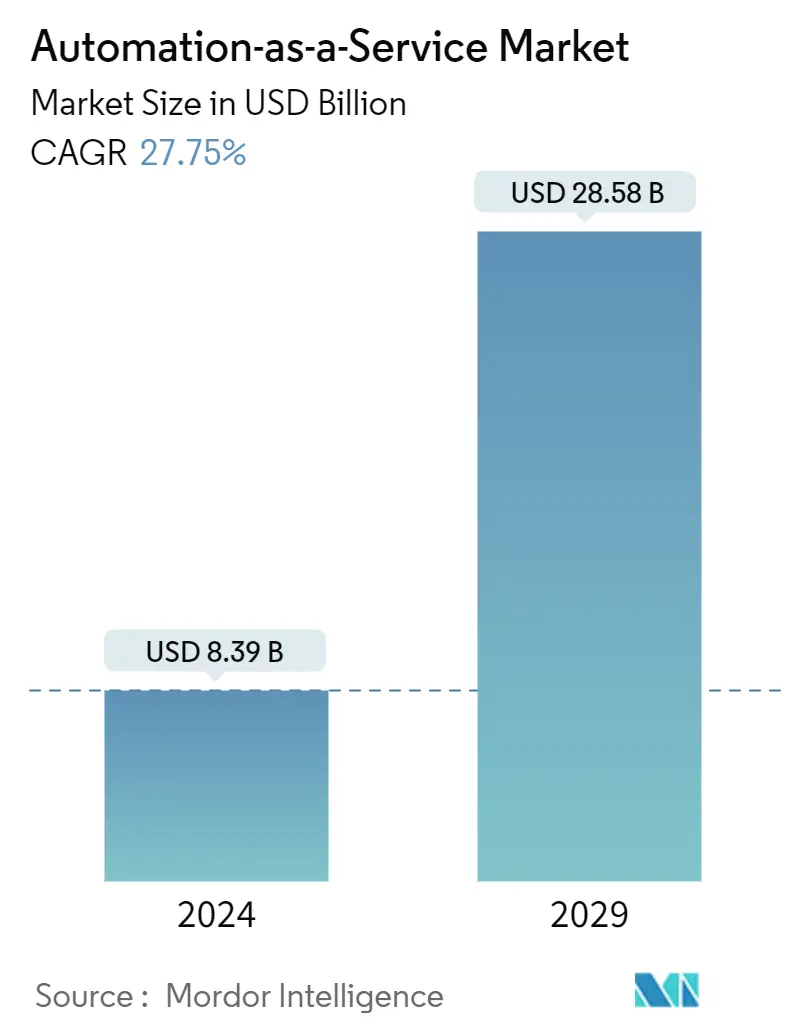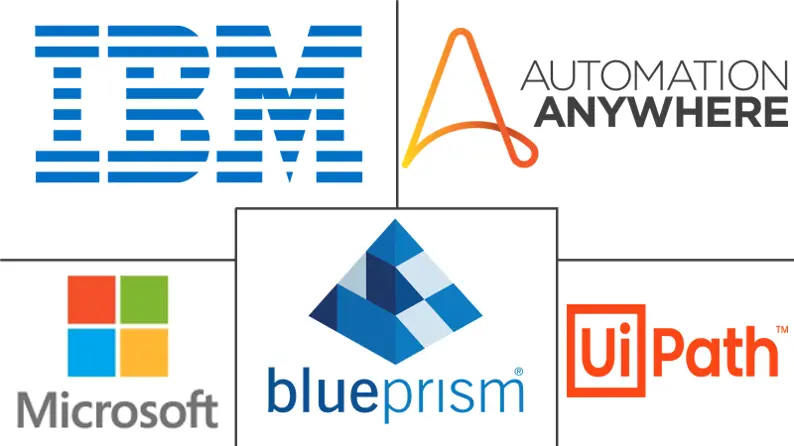Market Size of Automation-as-a-Service Industry

| Study Period | 2019 - 2029 |
| Market Size (2024) | USD 8.39 Billion |
| Market Size (2029) | USD 28.58 Billion |
| CAGR (2024 - 2029) | 27.75 % |
| Fastest Growing Market | Asia Pacific |
| Largest Market | North America |
Major Players
*Disclaimer: Major Players sorted in no particular order |
Automation as a Service Market Analysis
The Automation-as-a-Service Market size is estimated at USD 8.39 billion in 2024, and is expected to reach USD 28.58 billion by 2029, growing at a CAGR of 27.75% during the forecast period (2024-2029).
Some key reasons propelling the growth of the studied market are the increasing acceptance of automation across all end-user sectors, expanding the reach of cloud computing, and rising IoT device numbers. The need for healthcare services is anticipated to increase in the upcoming years. Many operations, including admissions and patient histories, need to be automated as most countries' healthcare infrastructure develops to manage massive amounts of patient data.
- The rapid development of new technologies like artificial intelligence (AI), machine learning, cloud computing, and the Internet of Things (IoT), as well as their widespread use by businesses, have contributed to the significant expansion of automation as a service (AaaS). According to Morgan Stanley, the estimated USD 1 trillion in sales for the AI business by 2050 will directly impact the AaaS market. The adoption of cloud-based solutions will rapidly grow as firms look for deployment options that hasten value realization. Due to the growth of their digital workforces, businesses invest in private or public clouds to automate labor-intensive, challenging-to-automate processes.
- Business process automation focuses on automating routine IT procedures and business services to increase productivity, cut expenses, and maintain smooth operations. The general use of BPA throughout organizations results from several factors, including businesses preparing to move their infrastructure to the cloud, bolstering business continuity, and enhancing corporate processes. For instance, Generali, a significant insurance provider in Europe, went from manual to automated business operations, saving time and money. Through repeatable procedures, this led to savings of up to 90% and a 50% decrease in the time required to underwrite challenging tasks.
- Adopting cloud solutions will expand significantly shortly as companies demand deployment options that enable them to gain benefits more quickly. Companies invest in a private or public cloud because they require flexible deployment and licensing choices as they increase their digital workforces to automate tasks. Consequently, the majority of market players focus primarily on cloud-based solutions. Amperity, a brand-new company founded in 2022, offers an enterprise data platform to transform fragmented consumer data into revolutionary cloud experiences.
- Data security and privacy are factors that companies should focus on as data loss is possible. Data loss is a threat from new cases like AlienBot, Wannacry, Cryptojackling, Fireball, Zeus, and others if a ransom is not paid for the decryption key to restore the data. These threats include spam emails, removable drives, potentially unwanted software, and suspicious websites. Over 600 Windows processes are blocked by the most recent malware, called Clop. Therefore, many organizations now include security in their plans to save money, protect the data, and lower the risk of an attack.
- The global demand for automation was accelerated and reemphasized by the COVID-19 pandemic. Across industries, there was an increase in cloud-native bots, intelligent data capture, and process discovery bots. There was a significant desire for automation to streamline tasks and cut expenses, as seen by the high rises in utilization rates from 60 percent to 95 percent reported by automation software vendors.
Automation as a Service Industry Segmentation
The phrase "automation as a service" describes a range of services related to corporate or industrial automation, including installation, support, consulting, and maintenance. The word frequently refers to adopting disruptive technologies and robotic or autonomous systems that can function with little to no human involvement.
The Automation-as-a-Service Market is segmented by Deployment Type (Cloud and On-premise), Business Function (Information Technology, Finance, Human Resources, Sales and Marketing, Operations), Enterprise Size (Large Enterprise, Small and Medium-sized Enterprise), End-user Vertical (BFSI, Telecom and IT, Retail and Consumer Goods, Manufacturing, Healthcare, and Life Sciences), and Geography(North America, Europe, Asia-Pacific, Middle east and Africa, Latin America). The report offers the market size in value terms in USD for all the abovementioned segments.
| By Deployment Type | |
| On-premise | |
| Cloud |
| By Business Function | |
| Information Technology | |
| Finance | |
| Human Resources | |
| Sales and Marketing | |
| Operations |
| By Enterprise Size | |
| Large Enterprises | |
| Small and Medium-sized Enterprises |
| By End-user Vertical | |
| BFSI | |
| Telecom and IT | |
| Retail and Consumer Goods | |
| Healthcare and Life Sciences | |
| Manufacturing | |
| Other End-user Industries |
| Geography | |
| North America | |
| Europe | |
| Asia Pacific | |
| Latin America | |
| Middle East and Africa |
Automation-as-a-Service Market Size Summary
The Automation-as-a-Service (AaaS) market is experiencing significant growth, driven by the increasing adoption of automation across various sectors, the expansion of cloud computing, and the proliferation of IoT devices. The healthcare sector, in particular, is expected to see a surge in demand for automation to manage the growing volume of patient data as healthcare infrastructure evolves. The rapid advancement and integration of technologies such as artificial intelligence, machine learning, and cloud computing are further propelling the market's expansion. Businesses are increasingly investing in cloud-based solutions to streamline operations, enhance productivity, and reduce costs, with a focus on automating labor-intensive processes. The COVID-19 pandemic has accelerated the demand for automation, highlighting the need for efficient and cost-effective solutions across industries.
North America stands out as a major contributor to the AaaS market, supported by the presence of leading IT companies and a robust investment landscape in technology startups. The United States, in particular, dominates the market due to its high connectivity, significant expenditure on AI technologies, and strong integration of IoT devices. The banking, financial services, and insurance (BFSI) sector is a key adopter of automation, leveraging robotic process automation to enhance customer service, optimize processes, and ensure regulatory compliance. The market is characterized by fragmentation, with numerous players engaging in strategic partnerships and acquisitions to enhance product offerings and market share. Innovations in automation technologies, such as natural language processing and intelligent automation systems, are further driving market growth, with companies like UiPath and Automation Anywhere leading the charge in integrating advanced technologies to improve business operations.
Automation-as-a-Service Market Size - Table of Contents
-
1. MARKET INSIGHTS
-
1.1 Market Overview
-
1.2 Industry Value Chain Analysis
-
1.3 Industry Attractiveness - Porter's Five Forces Analysis
-
1.3.1 Bargaining Power of Suppliers
-
1.3.2 Bargaining Power of Consumers
-
1.3.3 Threat of New Entrants
-
1.3.4 Threat of Substitute Products
-
1.3.5 Intensity of Competitive Rivalry
-
-
1.4 Assessment of COVID-19 impact on the Industry
-
-
2. MARKET SEGMENTATION
-
2.1 By Deployment Type
-
2.1.1 On-premise
-
2.1.2 Cloud
-
-
2.2 By Business Function
-
2.2.1 Information Technology
-
2.2.2 Finance
-
2.2.3 Human Resources
-
2.2.4 Sales and Marketing
-
2.2.5 Operations
-
-
2.3 By Enterprise Size
-
2.3.1 Large Enterprises
-
2.3.2 Small and Medium-sized Enterprises
-
-
2.4 By End-user Vertical
-
2.4.1 BFSI
-
2.4.2 Telecom and IT
-
2.4.3 Retail and Consumer Goods
-
2.4.4 Healthcare and Life Sciences
-
2.4.5 Manufacturing
-
2.4.6 Other End-user Industries
-
-
2.5 Geography
-
2.5.1 North America
-
2.5.2 Europe
-
2.5.3 Asia Pacific
-
2.5.4 Latin America
-
2.5.5 Middle East and Africa
-
-
Automation-as-a-Service Market Size FAQs
How big is the Automation-as-a-Service Market?
The Automation-as-a-Service Market size is expected to reach USD 8.39 billion in 2024 and grow at a CAGR of 27.75% to reach USD 28.58 billion by 2029.
What is the current Automation-as-a-Service Market size?
In 2024, the Automation-as-a-Service Market size is expected to reach USD 8.39 billion.

